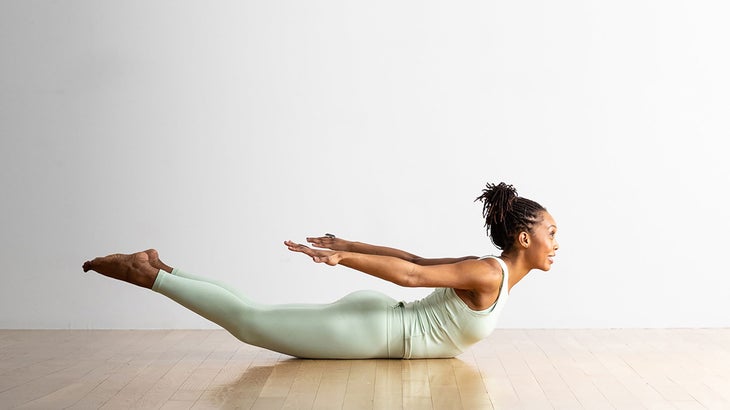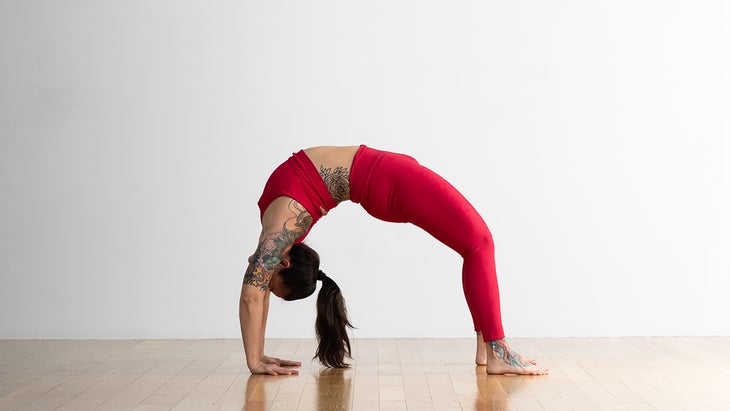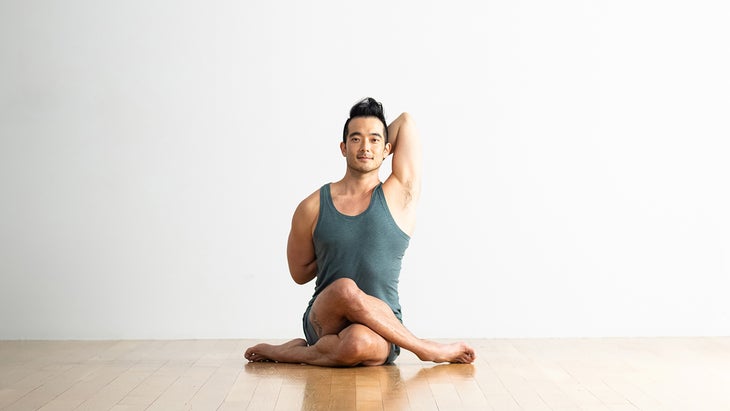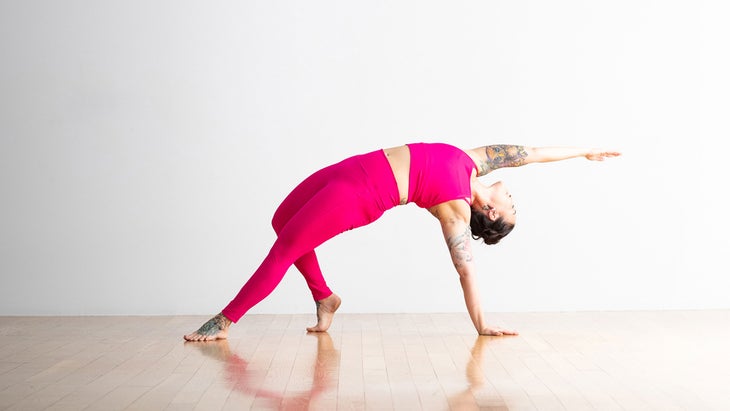“], “filter”: { “nextExceptions”: “img, blockquote, div”, “nextContainsExceptions”: “img, blockquote, a.btn, a.o-button”} }”>
I really try not to think about how many hours I spend hunched over my desk. When I’m done with that, I spend my free time propped up in bed or slouched on the couch with a book. I’m a side sleeper, too, which means I spend the night basically folded in half. So when my shoulders curve and my upper chest feels tight and caved in, I don’t have to wonder why.
While my posture in general isn’t terrible—thanks to yoga asana practice—my shoulder-forward habits may be training my body toward hyperkyphosis, the dreaded “dowager’s hump.”
That’s what happens when you habitually move in a certain way or hold your body in a certain position. Your body will begin to take on that shape, says Arturo Peal, a yoga teacher and anatomy expert based in New Orleans.
“All forms of connective tissue respond to stresses put on them,” he explains. “[They] respond to the pull of gravity and to the pull of muscles and tendons on them.”
He gives the example of musicians’ bodies. “I can look at a musician’s posture and see they have their left shoulder forward, their head is slightly rotated to the left. They’re probably a violinist or violist,” he says. “That’s [from] hours and hours of sitting in the same position.”
Yoga for counteracting poor posture
Yoga can be a brilliant tool for counteracting these habitual postures, he says. Throwing your shoulders back doesn’t stregthen your posture; an open chest and broad collarbone convey confidence and optimism.
“Doing full ranges of movement is really important,” Peale says. Fortunately, the shoulder is the most flexible joint in your body; you can move it in every direction.
And to release tightness across my upper chest—the area in front of the shoulder and just below my collar bone where the pectoral muscles attach–I’m adding poses that counter that forward pull. These asanas involve reaching back to employ the full range of motion in my shoulders. Here are seven poses I can add to my practice so I can stay proud of my posture.
Bitilasana (Cow Pose)
- Begin in Tabletop with your hips directly over your knees and your hands slightly ahead of your shoulders, shoulder-distance apart. Your wrist creases should be parallel to the front of your mat.
- Press down firmly through your hands.
- Inhale and arch your back by lowering your belly, lifting your chin and sternum, and broadening your collarbones.
- Keep the back of your neck long and your core slightly toned to find more movement in the mid and upper back. Broaden across your shoulder blades and draw your shoulders down, away from your ears.
- To release the pose, return to a neutral spine. Practice Marjaryasana (Cat Pose) as a counter pose.

Salabhasana (Locust Pose)
- Begin on your belly with your feet together and your hands reaching back, palms down.
- Extend your big toes straight back and press down with all ten toenails to activate your quadriceps.
- Rotate your inner thighs to the ceiling to broaden your lower back.
- Inhale and raise your head, chest, arms, and legs, leading with your inner thighs.
- Roll your shoulders back and up away from the floor and reach your hands toward your heels. Keep the back of your neck long and emphasize lifting your sternum instead of lifting your chin.
- To come out of the pose, slowly release your arms, legs, and head to the floor.

Dhanurasana (Bow Pose)
- Lie on your belly with a blanket under your pelvis if needed. Bend your knees and reach your feet toward your torso, keeping your toes active.
- Reach back with both hands to grasp the outer edges of your ankles. Flex your feet strongly.
- On an inhalation, lift your head, rib cage, and shoulders. On an exhalation, lengthen your tailbone, then lift your thighs and kick your legs back into your hands as you hold on firmly.
- From here, continue lift your sternum as you gaze forward.
- To come out of the pose, release your hold on your ankles and return to your starting position.

Urdhva Dhanurasana (Wheel/Upward-Facing Bow Pose)
-
- Begin lying on your back. Bend your knees and plant your feet hip-distance apart and parallel, directly under your knees.
- Reach back to place your hands alongside your ears with your palms down and your fingers pointing toward your shoulders.
- Without letting your feet or your knees splay apart, inhale, then use an exhalation to lift your hips, torso, and head enough to place the crown of your head on the mat. Do not rest any of your weight on your head.
- Draw your elbows toward one another, pull your upper arms into their sockets, and start to arch your middle and upper back.
- With the next inhalation, press down with your hands and feet, and lift into the pose.
- Rotate your inner thighs to the floor, and reach your tailbone toward the backs of your knees. Make sure your feet have not turned out, and root down with your big toe mounds.
- Let your head hang freely, and lift your sternum in the direction you are facing. Straighten your arms as much as possible but keep at least a slight bend in your knees.
- To come out of the pose, tuck your chin and lower your body to the floor. (Don’t put the crown of your head on the floor).

Dolphin Pose
- Begin in Tabletop position with your knees directly below your hips. Lower your forearms to the floor with your shoulders directly above your elbows.
- Curl your toes under, then exhale and lift your knees away from the floor. You may keep the knees slightly bent and the heels lifted away from the floor.
- Lengthen your tailbone away from the back of your pelvis and toward the pubis. Lift the sitting bones toward the ceiling, and from your inner ankles draw the inner legs up into the groins.
- Continue to press your forearms actively into the floor. Firm your shoulder blades against your back, then widen them away from the spine and draw them toward the tailbone.
- Hold your head between the upper arms; don’t let it hang or press against the floor. Lift the top of your sternum away from the floor.
- You can straighten your knees, but if your upper back rounds it’s best to keep them bent.
- To come out of the pose, release your knees to the floor with an exhale, and come down into Child’s Pose.

Gomukhasana (Cow Face)
- Start in Dandasana (Staff Pose), then cross your right leg over your left, and bring your right heel to the outside of your left hip.
- Bend your left knee, bringing your left heel to the outside of your right hip.
- Stack your right knee directly over your left, both knees facing directly forward.
- Press down evenly with your sitting bones, elongate your spine, and lift out of your lower back.
- Inhale, take your right arm out to the side and rotate it so your palm faces back and your thumb points down.
- As you exhale, bend your elbow and bring your right arm behind your back, with your palm facing out and the upper arm pulled in close to your body. Your elbow points towards your sacrum and your right fingers reach towards the base of your neck.
- With your next inhale, take your left arm out to the side and up to the ceiling with your hand facing the midline.
- Bend your left elbow and reach your hand down toward your neck. Bring your elbow in close to your face and up toward the ceiling as your hand reaches down the spine.
- Reach your hands toward each other until they touch. Clasp hands or fingers if possible.
- To exit the pose, exhale and carefully release your arms out to your sides and return to Dandasana. Repeat on the opposite side.

Camatkarasana (Wild Thing)
- Start in Adho Mukha Svanasana (Downward-Facing Dog).
- Bring your weight into your right hand and roll onto the outer edge of your right foot like Vasisthasana (Side Plank Pose).
- On an inhalation, lift your hips, bend your left knee. On an exhalation, step your left foot back and place your toes on the floor keeping your knee bent.
- Stay strong in your right hand, making a clawing action with the fingers. Keep the head of the right arm bone back.
- Arch through your upper back to create a sweeping action of the shoulder blades into the back of the rib cage.
- On an inhalation lift your hips higher until you curl more into a backbend with your right foot solid on the ground.
- Allow your head to extend back and extend your left arm from your heart to reach out overhead.
- To exit the pose, lower your hips and come to a seated position, or rotate your body to the left and return to Down Dog. Repeat on the other side.
